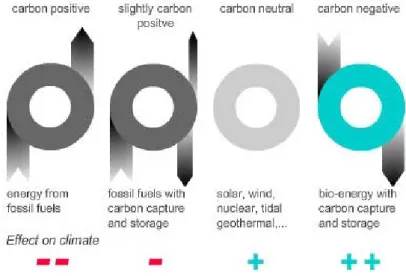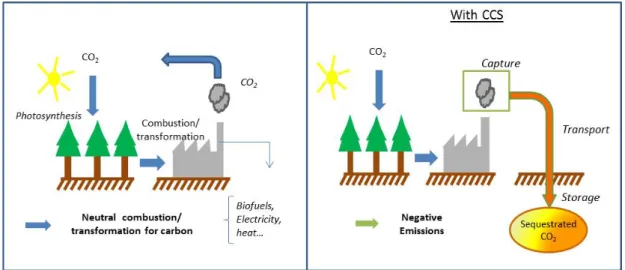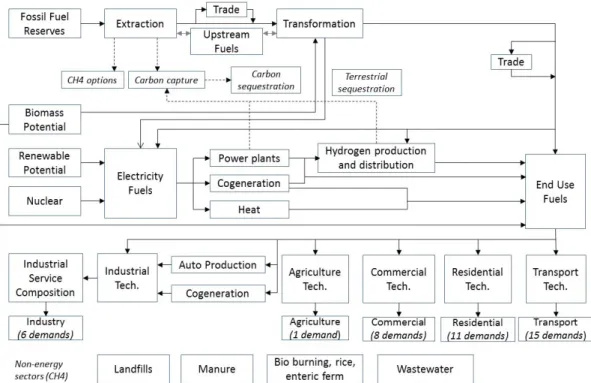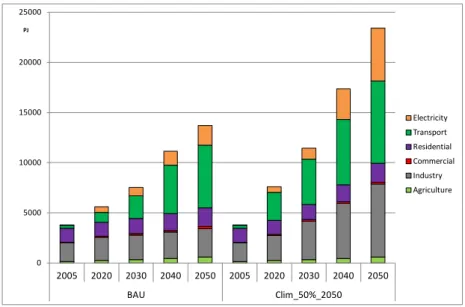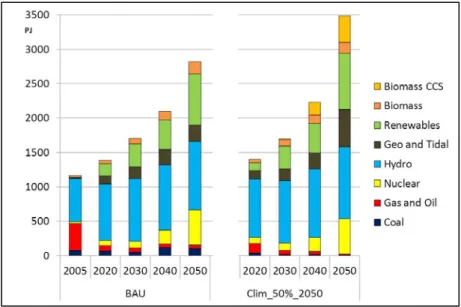HAL Id: hal-01274204
https://hal-mines-paristech.archives-ouvertes.fr/hal-01274204
Submitted on 15 Feb 2016HAL is a multi-disciplinary open access archive for the deposit and dissemination of sci-entific research documents, whether they are pub-lished or not. The documents may come from teaching and research institutions in France or abroad, or from public or private research centers.
L’archive ouverte pluridisciplinaire HAL, est destinée au dépôt et à la diffusion de documents scientifiques de niveau recherche, publiés ou non, émanant des établissements d’enseignement et de recherche français ou étrangers, des laboratoires publics ou privés.
Energy issue in Latin America face climate challenges
-A long-term analysis with TI-AM-FR
Sandrine Selosse, Sébastien Postic, Nadia Maïzi
To cite this version:
Sandrine Selosse, Sébastien Postic, Nadia Maïzi. Energy issue in Latin America face climate chal-lenges - A long-term analysis with TIAM-FR. [Research Report] Working Paper 2015-03-17, Chaire Modélisation prospective au service du développement durable. 2015, pp.12 - Les Cahiers de la Chaire. �hal-01274204�
Les Cahiers de la Chaire
Chair
e Modé
lisa
tion pr
ospectiv
e au se
rvice du dé
veloppe
me
nt dur
able
Energy issue in Latin America
face climate challenges
A long-term analysis with TIAM-FR
Sandrine Selosse, Sébastien Postic and Nadia Maïzi
MINES ParisTech - CMA
Energy issue in Latin America face climate challenges: A long-term analysis with TIAM-FR
Sandrine Selosse
1, Sébastien Postic and Nadia Maïzi
MINES ParisTech, PSL Research University, CMA - Centre for applied mathematics,
CS 10207 rue Claude Daunesse 06904 Sophia Antipolis Cedex, France
Abstract
Latin America presents important energy resources and a relatively low level of CO2 emissions. Energy needs
increase and are expected to increase more and more with the objective of development and of energy access. Moreover, Latin America is already impacted by climate change with, for example, first snow, inundation, etc. So to evolve his development in sustainable manner, low carbon strategy has to be developed. This paper focuses on long term analysis of energy climate issues in Latin America and particularly studies the impact of climate policy on its energy system. Solutions to tend toward a decarbonized system are analyzed and a focus is made on Biomass with carbon capture and storage (BECCS). Notably, an interesting result is the fact that, while the carbon capture and storage option is favored in case of bioplants development, appearing as a first climate-protect option, this is not the case with fossil power plants, and renewables development is preferred, even when BECCS is “excluded”.
Keywords
Global and regional energy system; GHG mitigation targets; long-term modeling; TIAM-FR; BECCS; Latin America; Climate change.
Acknowledgements
This research was supported by the Chair Modeling for sustainable development, driven by MINES ParisTech, Ecole des Ponts ParisTech, and AgroParisTech, supported by ADEME, EDF, GRTgaz, SCHNEIDER ELECTRIC and the French Ministry of Ecology, Sustainable Development and Energy
1. Introduction
The Latin America, for most of its countries, is well endowed with energy resources, 9% of the world energy is produced in Central and South America, these resources being widely used by North America or Europe. More precisely, Venezuela and Mexico rank among the 10 largest oil producers in the world; Bolivia, Colombia and Mexico have large deposits of gas; Brazil, Argentina and Mexico significant reserves of uranium; Argentina, Brazil, Paraguay and Venezuela can count on large water resources and important hydraulic potential. Moreover, nuclear programs are undertaken in Brazil and Argentina to ensure energy independence and diplomatic and the renewable energy share in TPES remains above the world’s average due to share of hydroelectricity. However, energy policies are characterized recently by a new problem: the environmental dimension. Even if GHG emissions represent only 5% of global emissions (according to UNEP), the Latin American countries are not
1
spared by the irregularity of the global climate: first snow in Argentina, floods in the Peruvian jungle, melting glaciers and Patagonian Andes, etc. This led energy policies need to discuss their orientation in the direction of sustainable development. Between privatization and sovereignty, liberalization and equity in access to energy, environmental protection and development, energy policy is thus face difficult choices and major, as energy is one of the foundations for the development economy. This work seeks to provide a technological vision of the energy issue in Latin America face climate challenges. CO2 intensity in Latin America is among the lowest worldwide, notably due to large
hydroelectricity share in the total primary energy supply and the CO2 per GDP and CO2 per capita
follow similar trend (low-middle levels of per capita incomes). But very high growth rates of energy demand are expected due to the rapid GDP growth (superior at 4%) and the rapid growth of energy demand (superior at 5%). Moreover, achieving the Millennium Development Goal (MDG) on Poverty reduction goal implies increasing consumption per capita in Central and South America. Latin American energy consumption is expected to grow, final energy consumption growing as countries converge from below towards higher levels of income during 2012-2030, so challenge is to grow with efficiency and low carbon impact. This paper focuses on long term analysis of energy climate issues in Latin America and particularly studies the impact of climate policy on the energy system at the global and regional scale, between industrialized, fast developing and developing countries. The purpose could be the regional distribution of CO2 mitigation to reach the 2°C objective, the technological
choice to tend toward a lower carbon society, the technological substitution according to the strength of climate ambition. This study is based on the TIAM-FR model and focus on Latin America. A climate constraint has been implemented in line with the 2°C objective of UNFCCC and with the ambition as precised by IPCC (2014, 2007).
Figure 1. Carbon balance of energy from different systems (source: Bellona)
Among technological options to mitigate greenhouse gas (GHG) emissions (Figure 1), Biomass Energy with Carbon Capture and Storage technology (BECCS) is gaining increasing attention. This option offers a unique opportunity for a net removal of atmospheric CO2 while it fulfills energy needs (Figure 2). But the BECCS implies technological readiness, development and social acceptance, etc. In addition, it involves a wide development of biomass power plant. So a substitutional solution in case of no deployment of this technology is explored.
Figure 2. Bioenergy and Carbon capture and storage
2. Methodology 2.1. The model
This research is developed with TIAM-FR (Loulou and Labriet, 2008), a bottom-up model describing the world energy system in great detail of current and future technologies expressed by region and sector. As a member of the TIMES family, TIAM-FR is a dynamic, linear programming, optimization model that proposes a bottom-up description of energy systems. It is based on a detailed description of existing and future energy technologies, which correspond to alternative pathways of all energy carriers from their sources to end-uses, through a wide array of conversion technologies. TIAM-FR computes a partial equilibrium on energy markets, in the sense that, at each time period, energy demand and supply are made to match (energy markets clear). This equilibrium feature is present at every level of the energy system: primary energy forms, secondary energy forms, and energy services. The optimization problem formulation in the TIAM-FR model mobilizes four types of entities (adapted from Loulou 2008), (i) decision variables: endogenous quantities to be determined by the optimization; (ii) the objective function: the criterion to be minimized or maximized; (iii) constraints: equations or inequalities involving the decision variables that must be satisfied by the optimal solution; and (iv) parameters entered by modelers as regards processes, technologies, etc. All TIAM-FR runs configure the energy system over a certain time horizon in such a way a total net present value of the stream of annual costs is computed for each region, discounted to a user selected reference year. These regional discounted costs are then aggregated into a single total cost constituting the objective function to be minimized under a number of constraints (Loulou, 2008). The net present value (NPV) of the total energy system costs for all regions is the sum of all annual costs per region r and year t, ACr,t, discounted at a dr,y general rate:
(
)
∑∑
= ∈ − + = R r t T t r t t t r AC d NPV 1 , , 0 1 (1) Where: t0 is the reference year for discounting; T is the set of years for which costs are incurred, which includes all years in the model horizon, plus past years (before the reference year t0) if costs have been defined for past investments, plus a number of years after the end of the planning period where some investment and dismantling costs are still being incurred, as well as the salvage value offixed capital; R is the set of TIAM-FR regions. An important feature is that global investment decisions are made in each period with full knowledge of the future cost and demand trajectories. In other words, the decision makers are assumed by the model to operate globally with the benefit of full information and perfect foresight (clairvoyance of energy planner).
TIAM-FR formulates and computes its projection of optimal energy systems based on the Linear Programming approach. It can be summed up as follows:
X c Min ⋅ (2) subject to
[ ]
[ ]
∑
= ≥ ∈ ∀ ∈ ∀ K k i i k t D t Q I i T t 1 ,( ) ( ) , 1 , 1 (3) and B⋅X ≥b (4)where X is the vector of all variables with associated discounted cost vector c, I the number of demands categories for energy services; Qk,i(t) the capacities of end-use technologies k susceptible of addressing service demand i at time t; Di(t) the exogenous demand for energy service i to be satisfied at time t; B and b vectors or matrixes of exogenous parameters (echoing emission contents and potential caps, energy contents and energy efficiency mandates, technology mandates, etc.). Expression (2) defines the total discounted cost to be minimized. Expression (3) formulates the set of demand satisfaction constraints. Expression (4) synthesizes the set of constraints weighing on the cost minimization, a large number of which express the physical and logical relations that must be satisfied in order to properly depict the energy system (Loulou, 2008).
In terms of policy assessment, TIAM-FR is a powerful tool for energy planning, energy technology penetration analysis and emission mitigation (technical) costs evaluation at regional and nationwide level. The model can inform policymakers on the opportunity to trade off different energy technologies, thus approaching an optimal allocation of resources, which is crucially important for resources saving and GHG mitigation portfolio design. The structure of the TIAM-FR model is defined by variables and equations extracted from and calibrated on data input, both qualitative and quantitative, from authoritative sources as the International Energy Agency (IEA) for energy balances, and from literature or expert knowledge (IPCC reports, US-Environmental Protection Agency, IEA-Energy Technology Perspectives, US-Department of Energy, US Geological Survey, World Energy Council, etc.) for the characteristics of the technologies and reserves of primary energies. The qualitative data includes lists of energy carriers, available technologies (across regions and time periods), as well as environmental externalities that are to be tracked. The quantitative data groups the technological and economic parameter values specific to each technology for each region and time period. Indeed, in the case of multi-region models, a technology often may be available for use in distinct regions; however, cost and performance assumptions may be different (Loulou and Labriet, 2008). This information collectively defines each TIAM-FR regional model database and the resulting mathematical representation of the Reference Energy System (RES) for each region (Figure 2). The RES network links commodities to several thousand existing and future technologies characterized by economic and technological parameters in all sectors of the energy system (agriculture, industry, commercial, residential and transport; taking into account the conversion and electricity sectors). The system includes the extraction, transformation, distribution and trade of various energy forms, and end-uses.
Figure 3. The Reference Energy System of the TIAM-FR model Source: Adapted from Loulou and Labriet, 2008
TIAM-FR covers the time horizon from 2005 to 2100; nevertheless, this study is investigated until 2050. This world model is geographically disaggregated into 15 world regions which Latin America and Mexico (Figure 3). This implies that energy systems of these regions are specifically filled. Furthermore, a climate module computes the change in CO2 concentrations in three reservoirs, the
total change in atmospheric radiative forcing from anthropogenic activities and the temperature change in two reservoirs relative to the pre-industrial period. Note that the climate module does not induce retroaction on energy services demands, which remain unchanged. More generally, TIAM-FR computes CO2, CH4 and N2O emissions from energy consumption.
Figure 4. The regional distribution of the TIAM-FR model
TIAM-FR is driven by 42 exogenous end-use energy demands grouped into six sectors: transport (15 demands), residential (11 demands), commercial buildings (8 demands), agriculture (1 demand), industry (6 demands) and other segments (1 demand) (Figure 2). Each energy demand is calibrated exogenously by the modeler for the base year, and then follows a trend induced by some exogenous driver, i.e. regional economic and demographic projections, such as the evolution of GDP, population or sectoral outputs over the time horizon (Figure 2). These drivers are obtained from accepted
external sources (Loulou and Labriet, 2008) or from other modeling experiments. Indeed, ETSAP-TIAM (another model of the TIMES family) partly derives them from a coupling experiment with the GEMINI-E3 model (Drouet et al., 2008) — which we examine in a further section. Demands are associated to their drivers through time- and region-specific elasticities that can reflect decoupling (elasticities smaller than 1, to account for saturations) or accelerated penetration assumptions (elasticities larger than 1). The model must satisfy these demands in each time period, by using the existing capacity and/or by implementing new capacity for end-use technologies. Thus, based on a set of coherent assumptions about the future pathways of demands drivers (demand side) and of technological characteristics and resources potentials (supply side), the model explores possible long-term energy futures on a given time horizon, under potential policy constraint, using linear programming to minimize the discounted costs of the global energy system (Reisman, 1997; Chen et al., 2007).
2.2. The climate scenario
For this study, we specify a global climate scenario, the Clim_50%_2050, corresponding to a 50% of CO2 emission reduction by 2050 by comparison with the 2000 level. The low carbon scenario requires
a global reduction of 4.98 Gt of CO2 in 2020 and 27 Gt of CO2 in 2050 (Figure 4). The most important
contribution comes from fast developing countries – China and India – followed by OECD and developing countries in similar efforts. More precisely, fast developing countries perform 39 and 43% of the CO2 emission reduction in 2020 and 2050 respectively. Industrialized countries, in turn,
perform 34% and 29% respectively in 2020 and 2050 against 27% and 29% for developing countries. So the contribution of developing countries in this scenario appears to be relatively very high; particularly, if we compare with the one of industrialized countries. However, it is interesting to note that the energy system of the developed countries is now fully decarbonised.
Latin America accounts for 7.4% of global CO2 emission in 2005 and, the climate policy investigated in
this analyze involve an emission reduction of near to 1 Gt of CO2 by 2050 (figure 4). Latin America
then contributes at 3% of the world CO2 emission reduction in 2050 (5.8% in 2020). Latin America
carries out 21% in 2020 and 11% in 2050 of the CO2 emissions reduction perfomed by developing countries in the strong climate scenario.
The question here is to discuss how to achieve this climate target and in same time satisfy the energy demand in Latin America? What are the most cost-effective climate change mitigation options available in the 2005-2050 period?
3. Energy issue in Latin America face climate challenges
The first result we can analyze is the impact on the primary energy in Latin America (Figure 5). It clearly appears a resource substitution between fossil and biomass. Renewables also increase but the biomass development is the most important impact.
Figure 6. The LAC primary energy by type
The focus on the biomass and alcohols (ethanol) uses highlights the increases of bio resources particularly in industrial, transport and electricity sectors (figure 6). These sectors, under the climate policy, evolve under a low carbon strategy. The deployment of biomass for energy uses has become one of the most complex, promising, politicized and debated options to combat climate change and to create a sustainable energy system.
Figure 7. The LAC primary energy: Biomass and Alcohols by sector
0 10000 20000 30000 40000 50000 60000 2005 2020 2030 2040 2050 2005 2020 2030 2040 2050 BAU Clim_50%_2050 Pj ALL OTHER RNW ALL ALCOHOLS ALL BIO ALL NUCLEAR ALL OIL PRODUCTS ALL GAS ALL COALS 0 5000 10000 15000 20000 25000 2005 2020 2030 2040 2050 2005 2020 2030 2040 2050 BAU Clim_50%_2050 PJ Electricity Transport Residential Commercial Industry Agriculture
In the electricity sector, the increase of biomass sources to the power generation is highlighted but particularly with a technological development and the use of carbon capture technologies. These technologies are not associated to coal or gas power plants but to the development of bioplants. Indeed, BECCS technologies allowing an opportunity to benefit from negative emissions, they appear here as a solution to reach high carbon reduction objectives. Other interesting options here consist in the development of renewables (essentially wind) and geothermal energy, with hydro but in a lesser extent.
Figure 8. The LAC electricity generation
The BECCS option implying technological readiness and development, for further investigation, we explored what could be the substitutional solution in case of no deployment of BECCS technology: renewables or CCS associated to fossil power plants?
Figure 9. The LAC electricity generation, without BECCS
We can note the large development of hydro and geothermal option and specially, the no development of CCS technology with fossil plant. The CCS technology so appears interesting in case
0 500 1000 1500 2000 2500 3000 3500 4000 2005 2020 2030 2040 2050 2005 2020 2030 2040 2050 Clim_50%_2050 Clim_50%_2050_NoBECCS PJ Biomass CCS Biomass Renewables Geo and Tidal Hydro Nuclear Gas and Oil Coal
of climate constrains in Latin America when it is associated with biomass but, otherwise, renewables development is favored. The power mix tends to become renewable, and the nuclear generation of electricity which remain a low carbon option and guarantee to satisfy electricity demand.
4. Conclusion
A climate constraint has been implemented in line with the 2°C objective of UNFCCC; so world CO2
emissions have to decrease by 50% in 2050 by comparison with the 2000 level and the regional contribution to the efforts is computed by the model. The contribution of Latin America to the CO2
emission reduction is particularly high at the beginning of the constraint period but decreases at the end, in 2050, due to a higher contribution of other developing countries. The attainability of CO2
mitigation targets depends notably on a wide range of different reduction options, the technology « readiness » of advanced technologies and the potential of deployment. According to the 5th assessment report from IPCC, all key mitigation options (energy efficiency, renewables, CCS) need to deliver to 2050 on a vast scale. Furthermore, between 250 and 300 EJ (a quarter to a third of the world’s energy supply in the second half of this century) may need to come from biomass to make that possible. Those targets accentuate the need for negative emissions on a large scale. This analysis is consistent with the necessity of large scale biomass deployment to meet the maximum temperature change of 2°C. According to IEA, as key challenges and opportunities, the integration of advanced (2nd generation / 2G) biofuel plants with conventional (1st generation / 1G) biofuel plants can lead to significant synergies and cost savings, especially for bioethanol plants. For biodiesel, conversion of fossil refineries to advanced biofuel production is another promising option as well. Another interesting result concerns the association of CCS technology to fossil plant as an option to climate constraints. Indeed, while this option is favored in case of bioplants, this is not the case with fossil power plants where renewables development is preferred, even when BECCS is “forbidden”. As technico-economic options, BECCS technologies certainly offer an interesting opportunity of negative emissions, but increase the level of CH4 emissions. So this impact is to consider and verify
for climate balance. Furthermore, Latin American countries already have in place policy incentives to promote penetration of renewable energy sources. However these incentives have limited impact over market realities and project economics of renewable energy sources. Regional realities and characteristics do not facilitate the development of continental opportunities. Notably the complexity of transnational cooperation highlights the interest for a disaggregated Latin American energy system model (Postic et al, 2015).
5. References
Azar C., Lindgren K., Obersteiner M., Riahi K., Van Vuuren D., Michel K. (2010),The feasibility of low CO2 concentration targets and the role of bio-energy with carbon capture and storage (BECCS),
Climatic Change, 100, pp. 195-202.
Katofsky R., Stanberry M., Frantzis L. (2010), Achieving climate stabilization in an insecure world: does renewable energy hold the key? Report International Energy Agency - Renewable Energy
Technology Development.
Luckow P., Wise M., Dooley J.J, Kim S. (2010), Large-scale utilization of biomass energy and carbon dioxide capture and storage in the transport and electricity sectors under stringent CO2 concentration limit scenario, International Journal of Greenhouse Gas Control, 4, pp. 865-877.
IPCC (Intergovernmental Panel on Climate Change) (2014), Climate Change 2014, Fifth Assessment
Report (AR5) Cambridge University Press, Cambridge.
IPCC (Intergovernmental Panel on Climate Change) (2007), Climate Change 2007, Fourth Assessment
Report (AR4), Cambridge University Press, Cambridge.
Loulou, R. and Labriet, M. (2008), ETSAP-TIAM: the TIMES integrated assessment model. Part I: Model structure, Computational Management Science, 5, 7-40.
Loulou R. (2008), ETSAP-TIAM, the TIMES integrated assessment model - Part II: mathematical formulation. Computational Management Science, 5, 41–66.
Obersteiner M., Azar C., Kauppi P., Möllersten K., Moreira J., Nilsson S. (2001), Managing Climate Risk, Science, 294, 5543, pp. 786–787.
Postic S., Selosse S. and Maïzi N. (2015), TIMES Prospective Modeling for South America, Working Paper, Les Cahiers de la Chaire, WP n°2015-01-15
